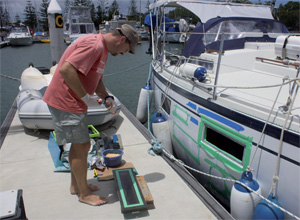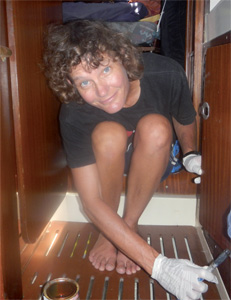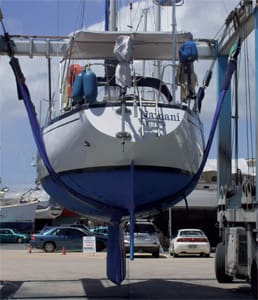Years before we contemplated a Pacific crossing, we had heard the rumors. Buy a boat in North America and sell it — maybe even at profit — in Australia. The idea of a one-way Pacific crossing has its appeal. So we started to plan and scheme, though concrete information on selling a boat on the other side of the world was hard to find. By the time we set our plan into motion and transited the Panama Canal in our 1981 Dufour 35 Namani, we found ourselves in good company with several other crews who had the same idea. But no one had anything better than anecdotal evidence to go on. How easy would it be to sell a boat in Australia? What are the myths, and what are the realities?
Now that we have the experience behind us, we and our fellow voyagers are happy to report a smooth, easy process. Most of us were able to sell our boats within two months of putting them on the market, and at reasonable prices, too. Cruisers hoping to do the same can certainly take heart, if not entertain fantasies of netting huge profits.
What sells
What type of boat sells well? What is the Australian market looking for? I asked Anita Farine of Farine Yacht Sales in Brisbane, who speaks from 15 years of experience. In general, she says the most sought-after boats are solid fiberglass monohulls in the 30- to 50-foot range dating from the mid-1980s to the mid 2000s. Older vessels also sell, she says, but for much lower prices. To illustrate the range of possibilities: Anita once sold a 50-foot Hallberg-Rassy for AU$500,000 back-to-back with a Westsail 32 for AU$60,000. “If it’s a boat,” she says, “I can sell it!”
 |
|
The surveyor tests Namani's hull. |
What about multihulls? South African-built catamarans in the 40- to 50-foot range get a lot of attention, though many of them price beyond the reach of the average buyer. The Australian market sees a lot of domestically built and homemade cats, whereas the population relies more heavily on imports when it comes to cruising monohulls. Still, Anita stressed that given a realistic asking price, just about any type of boat, rig or hull material can sell.
There seem to be two groups of buyers in Australia: the first are pleasure sailors, who appreciate well-equipped cruising boats. Much of Australia’s coast is rugged and exposed, so they look for good sail inventory, safety equipment and a full range of electronics. The second group is primarily looking to save costs by living aboard. These are often people who work in remote mining camps for several weeks at a time before returning to a home base. For them, life rafts and watermakers are far less important than comfort and livability.
What are some other points buyers look for? Price is obvious, and it is a savvy market. Buyers will hunt widely for good deals, even if import fees mean that most boats list for higher prices in Australia than they would in North America or Europe. Beware of pricing your boat significantly higher than others in its class, citing extras like electronics, life rafts and a wide inventory of sails. These are highly negotiable points, and you don’t want to price yourself out of the market. With plenty of reasonably priced boats available, any vessel that seems overpriced — regardless of how well-equipped it may be — is unlikely to attract a buyer.
Lesson number one: don’t aim for the stars in an asking price. One boat we know that listed at a very optimistic price languished at a marina berth for months before eventually selling for nearly half the asking price. Reasonably priced boats, on the other hand, attracted potential buyers quickly and sold within two months. Of course, you don’t want to list too low, either. It seems that just about every buyer’s first offer was AU$10,000 or more below the asking price. That is the time to consider taking the deal, possibly stripping down extras to sell separately on eBay (or its popular local equivalent, gumtree.com.au).
So, how much might your boat sell for? The accompanying “Case Studies” sidebar lists five concrete examples as a starting point. I recommend following website listings for an extended period of time to see how boats similar to yours price and move. The future is impossible to predict, and no market is immune in today’s economy. Although Australia has managed a smoother ride through recent years than many other countries, their high-riding dollar has lost a little of its brilliance in recent times.
When it comes down to details, one thing many buyers focus on is the age of the rig. In the state of Queensland, for example, insurance companies will not cover boats with rigs more than a decade old for anything but third-party liability. If your rig is aging, it may well pay off to get new rigging before your Pacific crossing. That way, you’ll benefit from the investment yourself and find selling easier.
Buyers also pay attention to engine hours and boat draft. Boats with drafts deeper than six feet strike out with many potential buyers; long keels, on the other hand, are fairly popular. Boats wired for the Australian standard of 220 volts are preferred over 110, though that shouldn’t be a deal-breaker. Sailors here will do their homework, too, looking for models that have proven themselves over the years. And if your schedule is flexible, it may help sweeten the deal to offer to deliver the boat yourself. We were based out of Brisbane and our offer to deliver to Cairns gave us the edge over other boats the buyer was considering.
Good presentation helps a sale, too. We spent a busy few days before arriving in Australia to take sales photos. In order to make the boat look as spacious and attractive as possible, we shifted huge amounts of gear from cockpit to forepeak and back again. Upon arriving in Australia, we spent several weeks making the boat picobello before showing it. That meant re-bedding hatches, touching up varnish work and scrubbing the deck. Watch for details that hit the eye, like worn upholstery or rusty spots. The trick is to make sure your boat gets its official valuation done before you make any improvements (more below).
When to list and where to sell
We were hardly halfway across the Pacific before the issues of when to list a boat and where in Australia to sell cropped up as discussion topics during beach potluck dinners. While it’s helpful to make contact with a broker as early as your departure from North America, it only really makes sense to list a boat in Australia once you reach Fiji, a few months prior to your arrival in Australia. That is close enough for the Australian buyer to conceive of the boat as being nearly there. Some buyers, of course, will travel offshore to see a boat. One Jeanneau we know of attracted an Australian buyer and signed a contract before they even left New Caledonia. We nearly had a buyer come visit us in Vanuatu, though he eventually pulled out to buy a Sydney-based vessel.
 |
|
Do your repairs and touchups after the boat valuation and before showing to potential buyers. |
The next question is what port in Australia to sell out of. Boats generally sell best in easily reached locations, meaning a marina berth in an area served by domestic airlines. High marina fees put Sydney out of the question for us. We headed to Scarborough, a suburb of Brisbane, to base our boat in a marina with reasonable fees (AU$500 per month for our 35-footer, AU$600 for 43 feet). Brisbane is the second biggest city in Australia with a high concentration of boats, and frequent air connections allow buyers to fly in from any part of Australia.
Another place frequently cited as a good base to sell a boat is Bundaberg, 200 nautical miles north of Brisbane. Several crews we spoke with reported making profitable sales here in years past. However, this trend may be on the wane. For many years, Bundaberg’s reputation rode the coattails of the popular “Port2Port” cruising rally that helped stock the local market. The demise of the rally might well mean the demise of the market in Bundaberg, especially given that connections in and out of the regional airport are limited. Still, a handful of sailors swear on Bundaberg, and who’s to argue with success?
Regulations and import duties
Importing a boat into Australia can be surprisingly easy. It seems that many of the wild rumors surrounding importation are patently false. For example, fumigation is rarely required. In 15 years of assisting boat owners to import, Anita Farine reports only one required fumigation — and that was a 75-year-old wooden hull. There is no required certification for rigging, nor proof of recent antifouling for boats under 20 meters — just make sure your hull isn’t sprouting a dense beard of mussels when you arrive. In the worst case, you’ll be required to haul out and clean the bottom. It will be necessary to certify refrigeration and gas systems, but these can be arranged locally with little difficulty (approx. AU$200 each).
Unfortunately, there is no way around the 10 percent import tax. Most boats also pay an additional 5 percent duty, though this is waived for US-flagged vessels thanks to the Free Trade agreement. These duties will take a significant chunk out of your take-home cash. I suspect that the stories of people selling a boat in Australia for a higher price than they bought it in North America does not figure in import duties. Some sailors try to bypass this by selling duty-free in New Caledonia, though the market there is limited.
A critical point for importation is the official valuation of your vessel. The lower the value of your boat, the lower the import duty you must pay. Therefore, make sure you hold off on touching up that scratch in the varnish or that nick in the gel coat until after the valuation has been made. It does not make sense to make major boat improvements in New Zealand or New Caledonia to improve the saleability of the boat in Australia since that will drive up the import value of your boat. Valuation is done by a surveyor or certified broker and is generally 50 percent less than the sale price of the boat. It is not possible to have valuation based on a bill of sale older than 12 months, not to mention that this is generally unfavorable, given that a bill of sale is likely to show a higher value than a local valuation will show.
Anita Farine recommends keeping receipts from as early as Panama for anything that could be construed as a boat improvement. For example, we were able to deduct the new rigging we had installed in Tahiti from the import value of our boat in Australia. Keep all major receipts — equipment, charts, antifouling, even marina fees. You never know what might be accepted as a deduction. Above all, talk to a broker well before your arrival in Australia for their advice on all importation requirements, including how and when to declare your intent to sell.
 |
|
Touching up the varnish helps your boat make a good impression on a buyer. |
Foreigner boats may remain in Australia for as long as three years before facing importation. Once a boat is listed for sale, however, a so-called Restriction to Port comes into effect. This means that you are limited to local cruising once your boat is imported. Keep this in mind when choosing a location. I originally entertained the fantasy that we could continue cruising Australia until a buyer appeared. Our broker dissuaded me, explaining that a roving boat is difficult to sell. This proved true, as many buyers ask to see boats on short notice.
Most of us awaiting a sale in Australia opened a local bank account, both for ease with daily transactions and for the eventual sale. Do not delay in opening a bank account because a strange regulation prevents foreigners from opening an account more than six weeks after their arrival.
For all of us selling our boat in Australia, the process was similar. After viewing the vessel, serious buyers paid a 10 percent deposit and arranged for haulout and survey (paid by the prospective buyer) as well as a brief sea trial. As long as everything checked out, the rest of the payment was made and the importation/sales process went through in roughly 10 days. This process was smoothed by our broker, who took a 10 percent fee. Other cruisers handled the work themselves.
We all went through a period of hopeful waiting, some longer, some shorter. No one struck the lottery, but most were satisfied with their sales. All agreed that the potential buyers we encountered were a bargain-seeking lot. In most cases, buyers were patient, too, suggesting that the onus is on the seller to accept a lower offer rather than lose a potential sale. It can be a nerve-wracking game of just how long you are willing to wait before accepting an offer. Ultimately, we were all sad to let go of our boats, yet relieved to find buyers after the voyage of our dreams.
Nadine Slavinski is the author of Lesson Plans Ahoy: Hands On Learning for Sailing Children and Home Schooling Sailors. Together with her husband and young son she cruised the Atlantic and Pacific on her 1981 Dufour 35, Namani.

